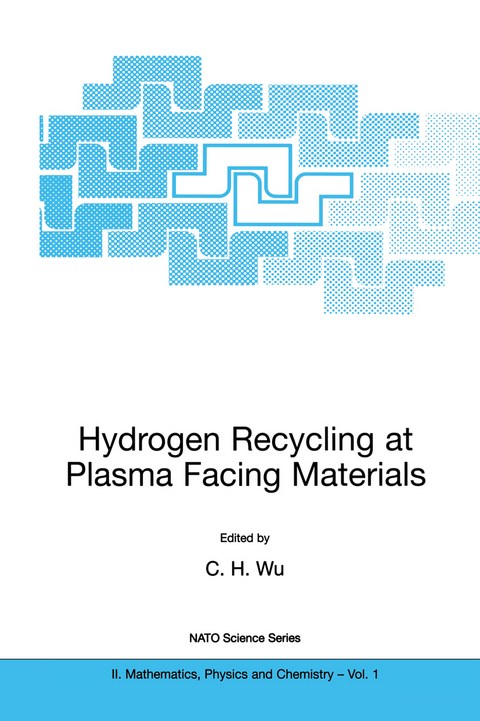
Hydrogen Recycling at Plasma Facing Materials
Springer (Verlag)
978-0-7923-6629-4 (ISBN)
The book discusses both laboratory experiments exploring the basic properties of non-equilibrium hydrogen-solid systems (diffusion, absorption, boundary processes) and experimental results obtained from existing fusion machines under conditions simulating future situations to some extent. Contributions are from experts in the fields of nuclear fusion, materials science, surface science, vacuum science and technology, and solid state physics.
1. Density control and plasma wall interaction in Tore Supra.- 2. Wall pumping and hydrogen recycling in TEXTOR 94.- 3. Hydrogen recycling in the RFX Reversed Field Pinch.- 4. Active control of hydrogen recycling by the permeation and absorption techniques.- 5. Deuterium pumping with superpermeable membrane in the divertor of JFT-2MTokamak.- 6. Wall pumping in Tokamak with lithium.- 7. Reflection and adsorption of hydrogen atoms and molecules on graphite and tungsten.- 8. Detached recombining plasmas in relation to volumetric hydrogen recycle.- 9. H? spectroscopic study of hydrogen behavior in a low temperature plasma.- 10. Metal surface microrelief formed due to sputtering by mono-and variable energy ions of hydrogen plasma.- 11. Recycled hydrogen in excited state.- 12. Main research results in hydrogen thermosorptive activation by metal hydrides.- 13. The modulated permeation technique used at the open university.- 14. A model for calculation of tritium accumulation and leakage in plasma facing sandwich structures.- 15. Transport of hydrogen through amorphous alloy.- 16. An interaction of hydrogen isotopes with austenitic Cr-Ni steels without and during reactor irradiation Hydrogen Recycle at Plasma Facing Materials.- 17. Diffusion of tritium in V, Nb and Ta under concentration, temperature and electric potential gradients.- 18. Deuterium superpermeation through niobium membrane.- 19. Effects of helium on the superpermeation of the group Va metals.- 20. Membrane bias effects on plasma driven permeation of hydrogen through niobium membrane.- 21. Plasma driven permeation through the NB membrane at low temperature.- 22. Phenomenology model of hydrogen evacuation by metal membranes.- 23. Hydrogen recycling and wall equilibration in fusion devices.- 24. Mechanisms oftritium retention in, and the removal of tritium from plasma facing materials of the Fusion Devices.- 25. Studies on tritium interactions with plasma facing material at the tritium process laboratory of JAERI.- 26. Tritium recycling and inventory in eroded debris of plasma-facing materials.- 27. Effects of Cu-impurity on retention and thermal release of D implanted into Be.- 28. Deuterium retention in beryllium and beryllium oxide.- 29. The effect of radiation damage and helium on hydrogen trapping in beryllium.- 30. Atomic hydrogen-graphite interaction.- 31. Deuterium retention in SI doped carbon films.- 32. Retention of 100 eV tritium in tungsten at high fluxes.- 33. Hydrogen absorption and desorption behavior with a boronized wall.- 34. Out of pile experiments on the investigation of hydrogen interaction with reduced activation ferritic-martensitic steel F82H.- 35. Structure and relief modification of titanium and boron modified graphite under light ion irradiation.- 36. The simulation of the diagnostic mirror behavior under hydrogen isotope irradiation.- 37. Surface loss probabilities of neutral hydrocarbon radicals on amorphous hydrogenated carbon film surfaces: consequences for the formation of re-deposited layers in fusion experiments.- 38. Device for investigations of tritium retention in and permeation through metals and structural materials.- 39. Thermocycling in gaseous hydrogen as a way of the hydrogen degradation acceleration.- Participants.
| Reihe/Serie | NATO Science Series II: Mathematics, Physics and Chemistry ; 1 |
|---|---|
| Zusatzinfo | 27 Illustrations, black and white; X, 363 p. 27 illus. |
| Verlagsort | Dordrecht |
| Sprache | englisch |
| Maße | 155 x 235 mm |
| Themenwelt | Naturwissenschaften ► Chemie ► Physikalische Chemie |
| Naturwissenschaften ► Physik / Astronomie ► Atom- / Kern- / Molekularphysik | |
| Naturwissenschaften ► Physik / Astronomie ► Plasmaphysik | |
| Technik ► Maschinenbau | |
| ISBN-10 | 0-7923-6629-8 / 0792366298 |
| ISBN-13 | 978-0-7923-6629-4 / 9780792366294 |
| Zustand | Neuware |
| Haben Sie eine Frage zum Produkt? |
aus dem Bereich


